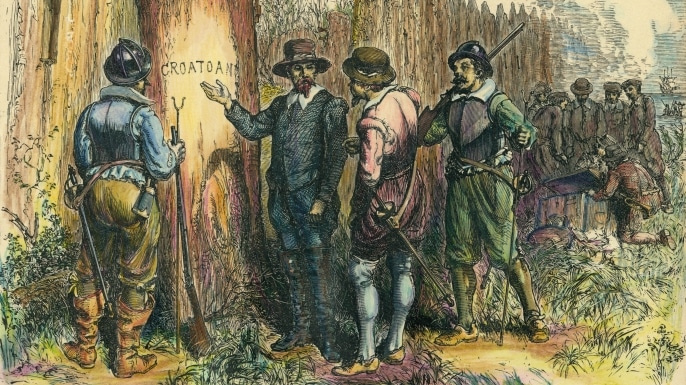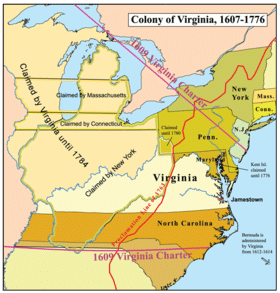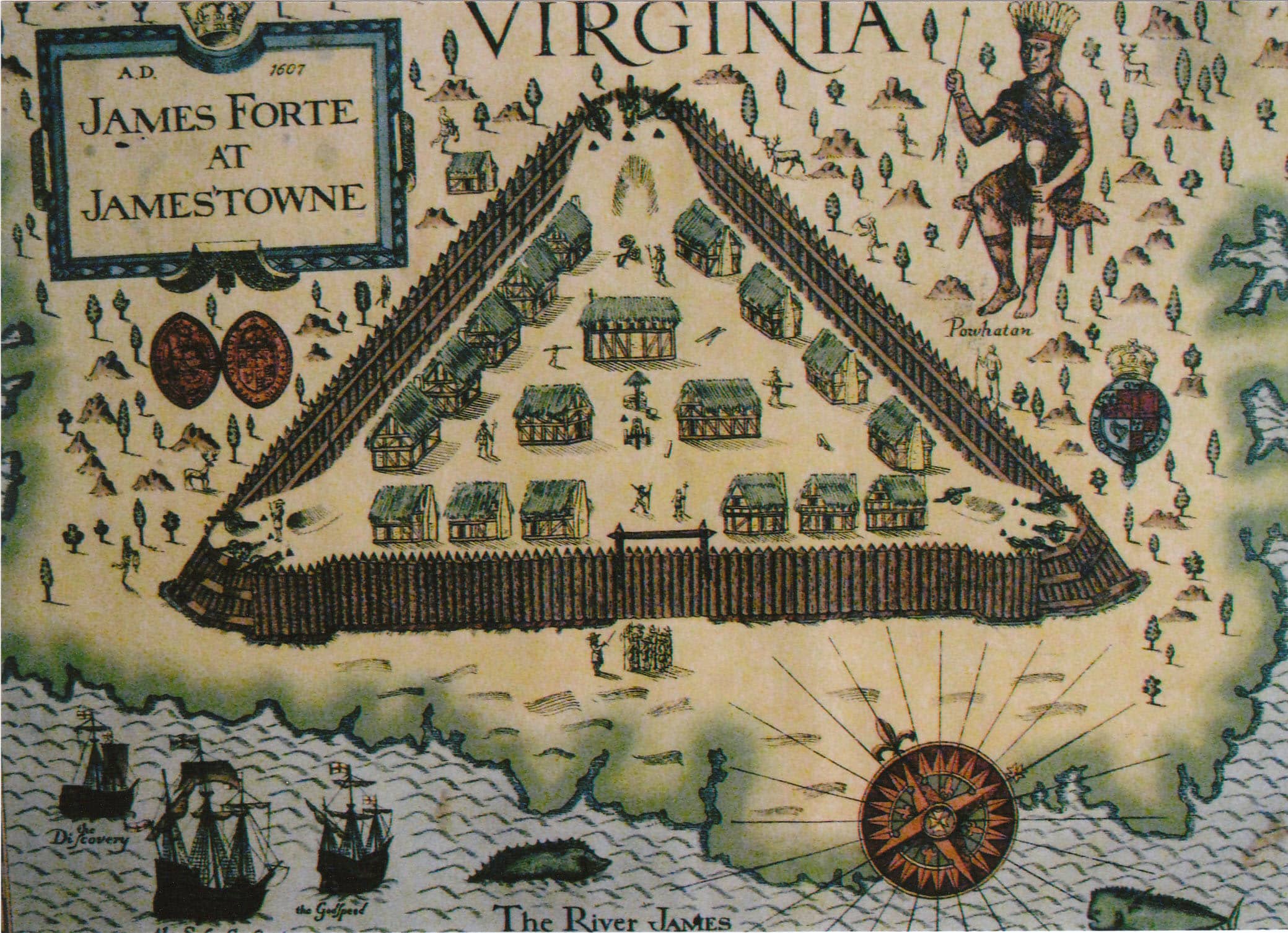Virginia Colony was a series of colonies that eventually grew into Virginia. By the time of the American Revolutionary War, Virginia was the largest and most influential colony in Colonial America.
The delegates that were sent from Virginia to the Continental Congress emerged as leaders for independence. George Washington, Thomas Jefferson, Richard Henry Lee, George Wythe, and Patrick Henry (Henry did not attend the Continental Congress but delivered an electric speech at the Stamp Act Congress) all had moments where they directly influenced the outcome of independence from Great Britain.
However, 1776 was a long way off for those who arrived in Virginia 190 years prior. In the early 17th century, the land that would become known as Virginia belonged to hostile and friendly natives.
The terrain was wooded and rough, but the soil was rich and full of opportunity. Those who would cross the Atlantic would come from different backgrounds and for different reasons.
Some came for religious freedom, some came for wealth, and some came because they saw an opportunity.
Jump to:
Virginia Colony Facts: Elizabethan Age
Queen Elizabeth had ushered in a golden age in England. Her father, King Henry VIII, had bankrupted the country while divorcing wives and separating from the Church in his quest for an heir. After his death, his son died, and Queen Mary came to power. Mary was more concerned with religion than progress and began to persecute the Protestants, earning her the nickname of "Bloody Mary."
Her reign was tumultuous and unfruitful and threw England into a dark age. Fortunately for the country, she died a premature death, and Elizabeth took over the throne. History affords us hindsight in which we can judge those in the past, but to Europe and to those in England, Elizabeth was not viewed as special.
She was the daughter of Anne Boleyn, who was Henry's second wife after the beloved Catherine of Aragon. Anne fell out of grace with the king when she failed to deliver him a male heir and was soon beheaded for treason. Elizabeth was third in line and viewed as a bastard child of a whore.
Henry VIII had invested money into a Navy (one of the few wise decisions he made), and it would be Elizabeth who would profit from that investment. The Spanish had become the dominant power in Europe. They profited from their discoveries in the Caribbean and their New World colonies.
For almost a century, they dominated the waters with little interference from the French, Dutch, and English. They had the most powerful Navy, the Spanish Armada, and ruled the seas. At the beginning of Elizabeth's reign, nobody would have foreseen their demise.
After the death of Queen Mary, her husband, Philip II of Spain, refused to recognize Elizabeth as the true monarch. Elizabeth, a Protestant and daughter of a beheaded Queen, was viewed as a heretic by the Catholic monarch of Spain. Philip began to devise a plan to invade England and take the throne back.
However, the great Spanish Armada met disaster. They were defeated at the Battle of Gravelines by Sir Francis Drake and then heavily damaged by terrible weather. Only half made it back to Spain. Although the defeat of the Spanish Armada did not immediately change the balance of power from Spain to England, it was clear that England was beginning to grow strong.
Roanoke

In 1584, Sir Walter Raleigh sent his first colonization mission to Roanoke. The first expedition was a research mission. The English wanted to learn the smelting techniques of the natives.
By learning their smelting techniques, the English could speed up their process from 16 weeks to 4 days and would give them an advantage. The settlement was abandoned when locals began to worry about conflicts with the native tribes. The colonists brought back with them tobacco, maize, and potatoes.
The second attempt to colonize Roanoke was in 1587 when Sir Walter Raleigh sent 150 colonists under the leadership of John White to Roanoke Island.
White returned to England for supplies that same year and was unable to return immediately due to a conflict between England and Spain (This was roughly the time of the Spanish Armada defeat).
When he finally returned in 1590, the colonists had abandoned Roanoke, and written on a tree was the word CROATOAN.
The colonists' departure did not seem forced, but they were never found. During this time, the first English baby born on American soil had been birthed. Her name is Virginia Dare.
The Colonists of Roanoke disappeared and left behind the words Croatoan. They were never found or heard from again.
King James

Queen Elizabeth died in 1603, and King James took her place on the throne. It would be under the leadership of King James that England began to successfully colonize the new world.
However, this decision did not come due to his curiosity about the New World but rather the need for England to find natural resources to support its population.
Decades of war had taken its toll on the English economy, and the coffers were now empty. England needed to revive its economy, and many men saw the opportunity in the New World.
Popham Colony
Popham Colony was not a permanent colony. The Plymouth Company sent colonists to the shores of the New World. These colonists set out with the goal to build a ship and sail it to England.
This would show that it was possible to use the timber in the New World to build English ships. This would become a vital resource to the depleted resources of England.
The colonists arrived in 1607 and were successful in their mission. They returned to England.
The Popham Colony was located in modern-day New England. However, it was known as Virginia during that time period.
Jamestown

Jamestown was the first permanent settlement in the New World for the English. It was settled in one of the worst locations possible and endured some extremely hard times.
There was a time known as the starving time in which many of the colonists died from lack of food. When the colonists arrived in Jamestown, there were approximately 500 colonists, and after the starving time, only 60 of them remained, which included John Smith.
The reason that Jamestown struggled was due to poor preparation. They were never supposed to grow their own food and were expected to live off wild game and trade with the natives.
However, there was not much wild game, the water was not suitable for drinking, and they were unsuccessful with trade. If it were not for the timely arrival of Lord Delaware and his Third Supply, the colony would not have survived.
John Rolfe, a colonist at Jamestown, had not seen much success in the New World. He had lost his wife and child at sea and had failed in business. He arrived at Jamestown with a new strand of tobacco seed.
That seed would change the fortunes of Jamestown forever. Rolfe became the first person to successfully raise tobacco in the New World.
He became extremely wealthy and married a young native named Pocahontas. They had a son named Thomas Rolfe.
Jamestown survived and became a wealthy colony for the British. With its success, other colonies began to be planned.
Pre-Revolution
After the success of Jamestown, other colonies in the New World began to spring up. The Pilgrims settled Plymouth, and eventually, the Puritans colonized Massachusetts Bay.
Maryland, Pennsylvania, North Carolina, South Carolina, and Georgia had all become successful English colonies by the time of the American Revolutionary War, and Virginia, with its successful tobacco crop, was the largest. The slave trade had also begun to thrive in Virginia and its southern colonies.
